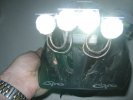You are hereRob's Homemade LEDs - Performance
Rob's Homemade LEDs - Performance
Don't look directly at the lights!
Erm... does my helmet need a wash? 
So - what everyone wants to know is, "Just how do these perform?"... the good news is: very, very well :)
I'm completely stoked with how the electronics came out. The control circuit works perfectly - dimming can be set as required and a nice low warning 'blink' 4 times a minute comes one to let you know it's time to be heading home.
After the low warning the circuit was designed to cut of the main lights completely - at 1v per cell voltage - to prevent damage to the battery pack. As it turns out, this cut off allows the battery voltage to recover and the main lights to then come back on momentarily. Basically - this forms a control feedback loop which never allows the battery voltage to drop to damaging levels while still supplying as much power as possible to the main lights. Ie. if the dimmer switch is left on full power this feedback control will gradually dim the light rather than cut it off (oh - all the while it is 'blinking' that low warning of course). Love the way this turned out, it's an unexpected bonus.
Beam Comparisons
Below are a few beam comparisons for your pleasure. All were taken with the camera on manual mode, same ISO/shutter settings to create a fair assessment. Distance between the tree stump foreground and large tree background (by the sign) is 22m, the camera is about 4m back from the stump.
And here are some more comparisons with other DIY and a couple of commercial lights, taken down by the creek at Manly Dam:
Don't be fooled into thinking the 50W Halogen is brightest, it's got good foreground spread, but look at the throw.
Battery Life
The first battery test conducted gave around 3h20m run time on full power. To be honest, this was a little disappointing but given it was the first cycle of the battery pack think it may improve.
Of course, one is rarely going to run this thing at full power for this long a period. There's still a very nice output while dimmed (see above), and having the voltage at that level set to drive LEDs at 260mA (calculated below) rather than the peak 700mA one should really expect well over twice the run time at that level.
Update: On the second discharge cycle of this pack the lights lasted a full 5 hours (well, 4h54m) before the low battery warning came on. Much more like it, and true testament to the fact one should cycle NiMH batteries a few times (well, at least once) before they are at full capacity.
At this point there was also an opportunity to take some current measurements, mostly 'just for fun' to try and shed light on the 3021 efficiency graph. Here's the result:
| Dimmer | Vin1 | Iin2 | Pin3 | 3021 Efficiency4 | PLED5 | ILED6 | VLED7 |
|---|---|---|---|---|---|---|---|
| Full | 21.30v | 450mA | 9.58W | 85% | 8.15W | 700mA | 2.91v |
| Full | 16.86v | 520mA | 8.77W | 90% | 7.89W | 700mA | 2.82v |
| Dim 18 | 16.86v | 190mA | 3.20W | 90% | 2.88W | 260mA | 2.82v |
| Dim 28 | 16.86v | 50mA | 0.84W | 90% | 0.76W | 70mA | 2.82v |
1 Voltage in from battery - measured.
2 Current from battery - measured.
3 Power = Current x Voltage.
4 Estimated from the graph on 3021 data sheet at Vin.
5 From input power and 3021 efficiency.
6 Fixed at 700mA by 3021 for Full. Calculated from VLED & PLED for others.
7 Voltage drop per LED from ILED & PLED for Full. When ILED not known fixed at known voltage from Full calculation.
8 Included as a comparision of how little power is used when the light is dimmed. ILED was not known at these levels but calculated from other known values.
On this showing, with this battery pack the light should run for over 13 hours on Dim 1, and around 50 hours on Dim 2 setting. Quiet impressive.
It's also interesting to note that if the 3021 is really supplying 700mA then the voltage drop across each LED is somewhat less than was allowed for. The XR-E data sheet states that VLED will be typically 3.75v at 700mA and 3.3v at 300mA with no minimum given. Perhaps there's something wrong with the measurements above, or maybe the discrepancy here is expected. Of course those voltages were calculated based on some assumptions about the 3021 efficiency also so there's probably a number of points for errors to creep in.
Heat
During this 'burn in' test a heat probe was jammed between the centre two lens tubes. At an ambient temperature of 26°C, the probe reported a gradually rise to 56°C after around 30 minutes. This rose a further 3° over the next couple of hours to peak 33° above ambient. The operating temperature of the LEDs is meant to be up to 85° but their brightness is also supposed to drop the hotter they get. Don't forget this is with four LED specific sinks and all the aluminium - while it seems to just about do the job, one should probably look for more heat dissipation in an ideal world.
Grand Total Bill of Materials
Not a bad deal at all... erm... at the time, this will probably look very expensive, very soon :(
| What | Cost | |
|---|---|---|
| Electronics | $159.58 | |
| Hardware | $18.30 | |
| Batteries | $109.00 | |
| Finishing | $12.80 | |
| Total | $299.68 |
Phew - comes in under the magic $300 mark... just!
External Links
Some links that you might find useful:Software
Cadsoft Online - Home of the EAGLE Layout Editor. There is no-way this would have been possible without this excellent schematic editor/PCB layout package. Grab the freeware for hobby use - amazing!
Sketchup - A bit tricky to get the hang of, but once one discovers it's all about grouping components very quick for drawing quick models, like the designs on the hardware page.
Suppliers
Newtons of Sale - Batteries & charger.
Jaycar Electronics - General electronics.
Dick Smith Electronics - General electronics.
Other Projects
High-power LED mountain bike light - Mouldy.org
Ultimate Night Vision Headlamp - Instructables
A "Do It Yourself" LED Bike Light Guide - Allen Chapman
quad XR-E bikelight - CandlePowerForums
DLH_2xCreeXRE - Some pictures of another nice project.
And don't forget to check Rob's LEDs MkII.
Commercial Manufactures
Well - the guys who were making proper attempts at it when this all started.
Lupine Lighting Systems
Ay Up! - Bike lights for the next generation?
- Login to post comments













